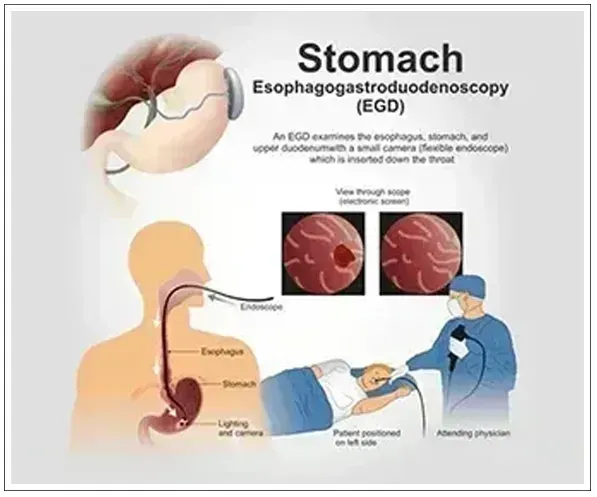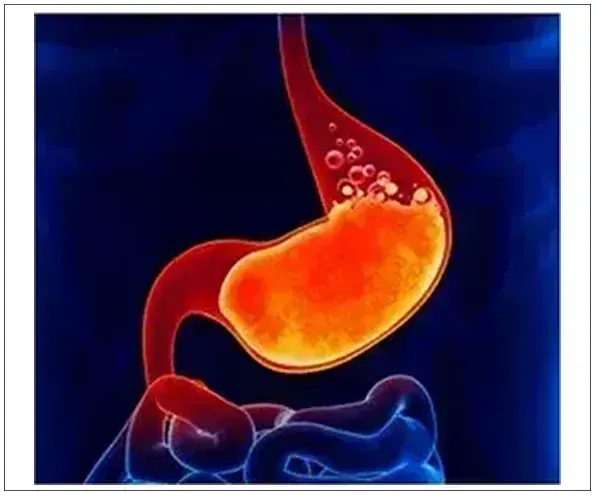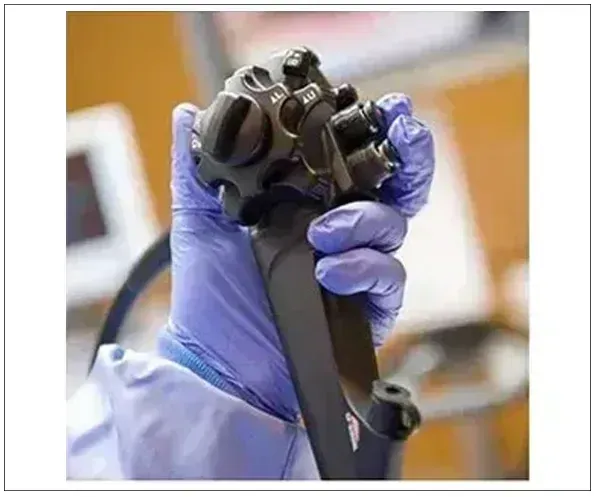

E.G.D - ESOPHAGO GASTRO DUODENOSCOPY
E.G.D. (ESOPHAGO GASTRO DUODENOSCOPY) allows your physician to view the inside of your o esophagus, stomach and duodenum (the first portion of the small intestine). A flexible rubber-like coated tube called an endoscope, passed through the mouth, will provide direct visualization of these areas. The actual process lasts only 10-20 minutes.
Many problems of the upper digestive tract cannot be diagnosed by x-ray. E.G.D. may be helpful in the diagnosis of inflammation of the esophagus, stomach, and duodenum (esophagitis, gastritis and dudenitis) and to identify the site of upper gastrointestinal bleeding.
E.G.D. is more accurate than x-ray in detecting gastric (stomach) and duodenal ulcers, especially when there is bleeding or scarring from a previous ulcer. E.G.D. may detect early cancers too small to be seen by x-ray and can confirm the diagnosis.

E.G.D. may also be needed for treatment, for example, for stretching narrowed areas of the esophagus or for removal of polyps or swallowed objects.
Using newer electro-cautery devices through the endoscope, bleeding from the upper gastrointestinal tract can be effectively controlled in the majority of cases.
Safe and effective endoscopic control of bleeding can drastically reduce the need for transfusions and surgery in these patients.

E.G.D. is an extremely worthwhile and safe procedure which is very well tolerated and is invaluable in the diagnosis and proper management of disorders of the upper digestive tract. The decision to perform this procedure was based upon assessment of your particular problem.
If you have any questions about your need for an E.G.D., do not hesitate to speak to your doctor. Both of you share a common goal-your good health - and it can only be achieved through mutual trust, respect and understanding.

Preparation for the test varies as to what time of the day you will be having the examination. If you are scheduled in the morning, do not eat or drink anything (including antacids) after midnight. Please check with your physician regarding any medication you are currently taking.
If you are scheduled in the afternoon, you may have two cups of clear liquids before 8:00 a.m., then nothing to eat or drink until after the examination.
A clear liquid diet contains no milk; it does include chicken broth, coffee or tea, soda, Gatorade, jello (no red or purple color) and fruit juices like apple, grape and cranberry.
If you have not already done so, you will have an opportunity to discuss this procedure with your physician or nurse. You will be asked if you are allergic to any medications. You will also be asked to remove dentures and/or glasses if applicable. You will be given a local anesthetic to numb your throat, mouth and tongue. The room will be darkened and you will lie on your left side for the procedure.
An intravenous medication (I.V.) will be given to help you relax and become drowsy. When you are properly relaxed, the endoscope will be passed. This is ordinarily accomplished with surprising ease, due to the relaxing effect of the sedation. The tube does not interfere with your breathing. Secretions will be suctioned out of your mouth throughout the procedure.
The room will be darkened during the examination which usually takes about 10-20 minutes. Often a biopsy (tiny bit of tissue) may be taken for microscopic examination. You will feel no discomfort when the biopsy is done. Photos may also be taken. The specimens are sent to the laboratory for examination by a pathologist. Reports are usually available within one week.
As soon as the endoscope is removed, your blood pressure and pulse will be recorded. You will be moved to the Recovery Area where your vital signs will be monitored for 30 minutes. Your physician will then discus the results of the procedure with you and a family member.


ARE THERE ANY COMPLICATIONS FROM E.G.D.?
E.G.D. is safe and is associated with very low risk when performed by physicians who have been specially trained and are experienced in this endoscopic procedure. Complications can occur but are rare.One possible complication is perforation in which a tear through the wall of the oesophagus or stomach may allow leakage of digestive fluids. This complication may be managed simply by aspirating the fluids until the opening seals, or you may require surgery.
Bleeding may occur from the site of biopsy or polyp removal, it is usually minimal but rarely may require transfusions or surgery.Localized irritation of the vein may occur at the site of medication injection. A tender lump may develop and could remain for several weeks.Other risks include drug reactions and complications from unrelated diseases such as heart attack or stroke. Death is extremely rare but remains a remote possibility.
The only discomfort following the examination is generally limited to a mild sore throat and/or a need to "burp" the air which has been put in the stomach during the examination.If you have any questions about the examination, please feel free to discuss them with your physician or one of the nurses. If your procedure is being done at one of the above hospitals, please call to pre-register one to two days prior to your procedure. Pre-registration of your insurance information will avoid delays the day of your procedure. The telephone number is listed with the designated hospital.